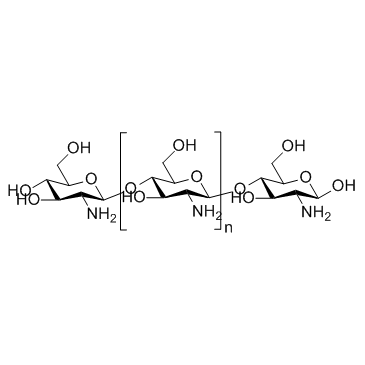Chitosan (Deacetylated chitin) |
| رقم الكتالوجGC34082 |
الشيتوزان (الكيتين المنفصل الأسيتيل) (الكيتين المنفصل الأسيتيل) عبارة عن عديد السكاريد الخطي متعدد التكوينات مشتق من الكيتين.
Products are for research use only. Not for human use. We do not sell to patients.

Cas No.: 9012-76-4
Sample solution is provided at 25 µL, 10mM.
Chitosan is a natural polycationic linear polysaccharide derived from chitin.
Chitosans are recognized as versatile biomaterials because of their non-toxicity, low allergenicity, biocompatibility and biodegradability. Chitosan is reported to have other biological properties, such as antitumor, antimicrobial, and antioxidant activities. It can be used in water treatment, wound-healing materials, pharmaceutical excipient or drug carrier, obesity treatment and as a scaffold for tissue engineering[1]. Antimicrobial activity of chitosan has been demonstrated against many bacteria, filamentous fungi and yeasts. Chitosan has wide spectrum of activity and high killing rate against Gram-positive and Gram-negative bacteria, but lower toxicity toward mammalian cells[2]. Chitosan exhibits antitumor activity against different types of cancer. For example, chitosan decreases adhesion of primary melanoma A375 cell line and decreases proliferation of primary melanoma SKMEL28 cell line, it has potent pro-apoptotic effects against RPMI7951, a metastatic melanoma cell line[3]. Chitosan and its derivatives act as antioxidants by scavenging oxygen radicals such as hydroxyl, superoxide, alkyl as well as highly stable DPPH radicals in vitro[4].
Chitosan treatment dramatically increases lifespan and inhibits tumor metastasis especially in treatment groups of the low-molecular weight compound[5]. Chitosan has some apparent treatment effects on rat PCP by reducing HSP70 mRNA expression and lung inflammation, increasing the concentrations of IL-10 and IFN-γ as well as CD4(+) T-lymphocyte numbers, reducing the CD8(+) T-lymphocyte numbers and the concentration of TNF-α and inducing significant ultrastructural damage to P. carinii[6].
[1]. Cheung RC, et al. Chitosan: An Update on Potential Biomedical and Pharmaceutical Applications. Mar Drugs. 2015 Aug 14;13(8):5156-86. [2]. Kong M, et al. Antimicrobial properties of chitosan and mode of action: a state of the art review. Int J Food Microbiol. 2010 Nov 15;144(1):51-63. [3]. Gibot L, et al. Anticancer properties of chitosan on human melanoma are cell line dependent.Int J Biol Macromol. 2015 Jan;72:370-9. [4]. Younes I, et al. Chitin and chitosan preparation from marine sources. Structure, properties and applications. Mar Drugs. 2015 Mar 2;13(3):1133-74. [5]. Yeh MY, et al. Effects of chitosan on xenograft models of melanoma in C57BL/6 mice and hepatoma formation in SCID mice. Anticancer Res. 2013 Nov;33(11):4867-73. [6]. Liu AB, et al. Therapeutic efficacies of chitosan against Pneumocystis pneumonia of immunosuppressed rat. Parasite Immunol. 2014 Jul;36(7):292-302
| Cas No. | 9012-76-4 | SDF | |
| Canonical SMILES | O[C@H]1[C@H](O)[C@@H](N)[C@H](O[C@H]2[C@H](O)[C@@H](N)[C@H](O[C@H]3[C@H](O)[C@@H](N)[C@H](O)O[C@@H]3CO)O[C@@H]2CO)O[C@@H]1CO.[n] | ||
| Formula | (C6H13NO5)n | M.Wt | 161.16(monomer) |
| الذوبان | Water : 0.67 mg/mL (ultrasonic and adjust pH to 3 with HCl);Water : < 0.1 mg/mL (insoluble);DMSO : < 1 mg/mL (insoluble or slightly soluble) | Storage | Store at -20°C |
| General tips | Please select the appropriate solvent to prepare the stock solution according to the
solubility of the product in different solvents; once the solution is prepared, please store it in
separate packages to avoid product failure caused by repeated freezing and thawing.Storage method
and period of the stock solution: When stored at -80°C, please use it within 6 months; when stored
at -20°C, please use it within 1 month. To increase solubility, heat the tube to 37°C and then oscillate in an ultrasonic bath for some time. |
||
| Shipping Condition | Evaluation sample solution: shipped with blue ice. All other sizes available: with RT, or with Blue Ice upon request. | ||
Step 1: Enter information below (Recommended: An additional animal making an allowance for loss during the experiment)
 g
g
 μL
μL

Step 2: Enter the in vivo formulation (This is only the calculator, not formulation. Please contact us first if there is no in vivo formulation at the solubility Section.)
Calculation results:
Working concentration: mg/ml;
Method for preparing DMSO master liquid: mg drug pre-dissolved in μL DMSO ( Master liquid concentration mg/mL, Please contact us first if the concentration exceeds the DMSO solubility of the batch of drug. )
Method for preparing in vivo formulation: Take μL DMSO master liquid, next addμL PEG300, mix and clarify, next addμL Tween 80, mix and clarify, next add μL ddH2O, mix and clarify.
Method for preparing in vivo formulation: Take μL DMSO master liquid, next add μL Corn oil, mix and clarify.
Note: 1. Please make sure the liquid is clear before adding the next solvent.
2. Be sure to add the solvent(s) in order. You must ensure that the solution obtained, in the previous addition, is a clear solution before proceeding to add the next solvent. Physical methods such as vortex, ultrasound or hot water bath can be used to aid dissolving.
3. All of the above co-solvents are available for purchase on the GlpBio website.
Quality Control & SDS
- View current batch:
- Purity: >98.00%
- COA (Certificate Of Analysis)
- SDS (Safety Data Sheet)
- Datasheet
Average Rating: 5 (Based on Reviews and 8 reference(s) in Google Scholar.)
GLPBIO products are for RESEARCH USE ONLY. Please make sure your review or question is research based.
Required fields are marked with *



















